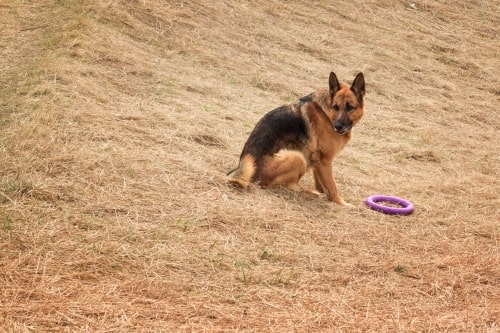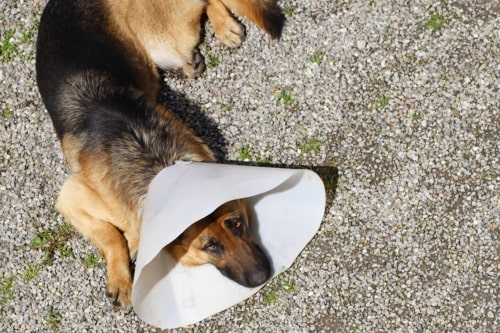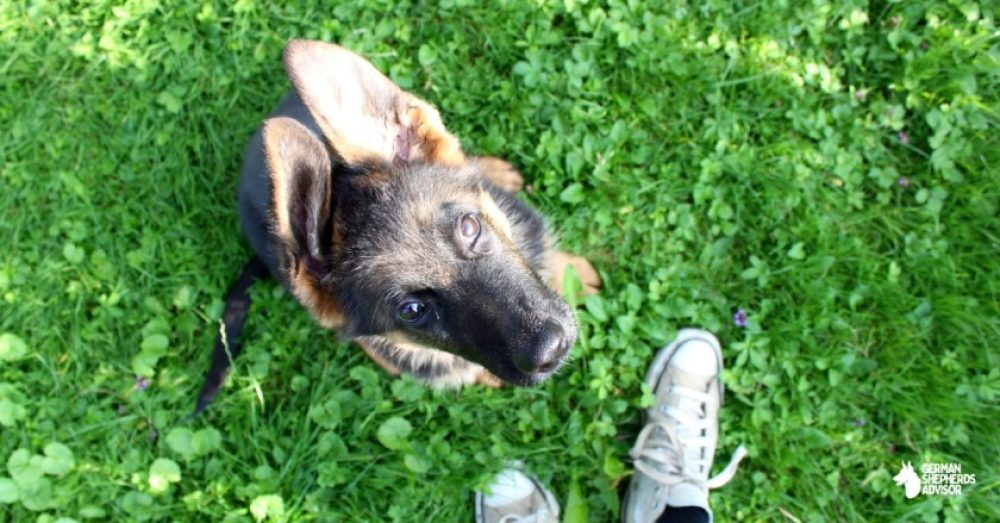We’ve all seen it – the German Shepherd that circles its owner. It can be annoying or even dangerous for an untrained dog, but there are some good reasons why your GSD may be doing this.
Reasons behind circling
The first reason is simply because they want to come closer to you. Catching up with their pack leader (you), carrying out a command, sniffing something on the ground, all of these things can explain away simple circling. To stop your pup from circling, simply call his name and give the “come” command before he starts down his path. If he responds to your voice quickly enough he won’t have time to turn around before you correct him by calling him back to your side and rewarding him with a treat and affection.
If this doesn’t work, it may be because your dog is anxious about something in the environment around you. This could be the presence of another person or animal, traffic noise, moving carpet on the sidewalk – anything that can make even the most confident dog want to come back and check up on his owner. If this is what’s happening, stop walking for a moment and allow your GSD to sniff the area around you. After he has taken time to investigate whatever has caught his attention, give him some praise for being such a good boy and continue on your walk as normal (don’t forget to switch directions or change direction entirely).
Puppies often circle because it’s how they learn to walk. They will naturally circle around their mother until she corrects them, so this can continue into adulthood if not corrected.
Circling behavior
Human beings are not the only ones who form attachments to items, places, and even other species. The same is true in dogs.
Researchers have observed a dog’s tendency to “place” objects between herself and a human or another animal she wishes to keep at a distance from her face. This behavior is called “circling,” and it may indicate a negative emotional response in dogs, such as fearfulness or defensiveness.
Circling behavior can include any of several behaviors that ultimately result in the dog placing an object between itself and whatever she does not want near her, including circling her body around an object so that she ends up on the opposite side from another individual. In some cases, this action results in the dog touching the object with her nose, which may serve an investigating or exploratory purpose. If a dog circles another individual in order to keep her at a distance from the face, this action is more likely associated with negative emotions such as fearfulness and defensiveness.

Dog trainers have observed that some dogs form attachments not only to items but also to other species, including cats and even horses. In fact, researchers writing in Applied Animal Behaviour Science journal have suggested that dogs’ understanding of others’ minds—what humans call “theory of mind”—may be why they tend to seek out relationships with members of other species. This theory argues that animals do not simply live their lives on instinct;, they are aware enough to understand that other beings have different thoughts, feelings, and motivations than they do.
Why does my german shepherd circle me?
This awareness of others’ minds may be why some dogs are uncomfortable with physical affection from human beings. Researchers writing in Behavioural Processes journal observed that when a dog was pushed over the threshold of tolerance by being petted by humans, she would abruptly push herself out of reach to avoid them—because she understood their motivation for touching her.
A study published in Applied Animal Behaviour Science has found that “circling behavior” is influenced by genetics. At the University of Veterinary Medicine in Vienna, researchers performed genetic analyses on two cohorts of Border Collies: one group raised as pets and another group raised on farms. The researchers concluded that there was a significant genetic component to this behavior, meaning that it arises due to biological conditions.
As pet owners know, dogs are very sensitive to the emotions of their human friends and will adjust their own behavior accordingly. While dog trainers have observed that some dogs form attachments not only to items but also to other species, including cats and even horses, circling another individual in order to keep her at a distance from the face is more likely associated with negative emotions such as fearfulness and defensiveness.
Researchers writing in Applied Animal Behaviour Science journal have suggested that dogs’ understanding of others’ minds—what humans call “theory of mind”—may be why they tend to seek out relationships with members of other. This theory argues that animals do not simply live their lives on instinct;, they are aware enough to understand that other beings have different thoughts, feelings, and motivations than they do.
This awareness of others’ minds may be why some dogs are uncomfortable with physical affection from human beings. Researchers writing in Behavioural Processes journal observed that when a dog was pushed over the threshold of tolerance by being petted by humans she would abruptly push herself out of reach to avoid them—because she understood their motivation for touching her.
A study published in Applied Animal Behaviour Science has found that “circling behavior” is influenced by genetics and results from biological conditions rather than environmental factors such as training and socialization. At the University of Veterinary Medicine in Vienna, researchers performed genetic analyses on two cohorts of Border Collies: one group raised as pets and another group raised on farms. The researchers concluded that there was a significant genetic component to this behavior, meaning that it arises due to biological conditions.

Some people think that dogs avoid physical affection from humans because they understand their motivation for touching them (i.e., the fact that humans like to touch and pet them). Researchers writing in Behavioural Processes journal observed that when a dog was pushed over the threshold of tolerance by being petted by humans she would abruptly push herself out of reach to avoid them—because she understood their motivation for touching her.
This question has been on the minds of many a new GSD owner. It’s an adorable sight to see a young pup or even a grown dog racing around in circles before plopping down for a nice long nap. While this behavior seems normal, it is important to understand why this happens and if there might be some underlying problem that needs treatment.
The most common cause of circling is vestibular disease which affects the inner ear causing the dog to feel as though they are spinning or falling over. Some other diseases such as idiopathic epilepsy, brain tumors, Cushing’s syndrome, hypothyroidism and more can also cause this behavior. If your dog begins circle running all of a sudden, then the behavior is most likely caused by a disease that requires immediate treatment.
A less likely cause is a condition known as PICA which is usually seen in dogs with an iron deficiency. What happens here is that the dog will begin to eat objects such as rocks and sticks in order to compensate for the lack of iron. In some cases, this might be due to parasites or foreign bodies stuck in your dog’s intestines causing irritation which would also require immediate attention from your veterinarian.
Another possible reason why your German shepherd starts circling around you could be because they are trying to lay down flat on their side without being able to control their hind legs properly. This can occur if there has been damage done to the rear end of the brain, the cerebellum. This disease is known as Wobbler syndrome and can be diagnosed by your veterinarian with a series of tests.
While some cases of circling are caused by diseases that require immediate attention, there are also some harmless reasons for this behavior to occur in certain dogs. Some breeds including Labradors, Golden Retrievers and Collies might develop their own version of this at a young age without any underlying cause or health concerns. It seems that they are just playing when they run in circles before plopping down for a rest.
FAQS
When to know a dog needs medical help?
If you notice your dog racing around in circles more frequently than usual then it would be best to take them immediately to your veterinarian for an examination. If they seem healthy otherwise then perhaps your family dog has simply developed a little quirk of their own.
Where do shepherds get circling behavior from?
circling behavior” is influenced by genetics and results from biological conditions rather than environmental factors such as training and socialization.

